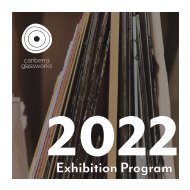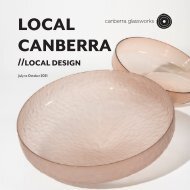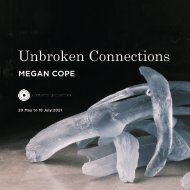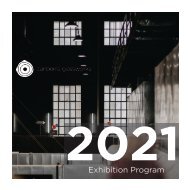2020 Learning Resource - R4aR I Spy in the Deep Blue Sea
Create successful ePaper yourself
Turn your PDF publications into a flip-book with our unique Google optimized e-Paper software.
CREATE YOUR OWN
I SPY
IN
THE
DEEP
BLUE
SEA
AN ACTIVITY RESOURCE BASED ON
THE PROGRAM PRESENTED BY
CANBERRA GLASSWORKS FOR
NATIONAL SCIENCE WEEK 2020
REQUIEM FOR A REEF
WHAT CAN YOU SEE IN THE SEA?
Learning about the ocean can help us build a connection and develop a sense of ownership and
responsibility for the future of the world's oceans.
Capture the magnificent beauty of the Great Barrier Reef using transparent and opaque paper to create a
seascape filled with your favourite plants, animals and creatures that live under the sea. The visual effect of
cellophane is used as an introduction to working with glass.
Explore the concepts of colour, transparency and light reflection and refraction.
Photo Credit (background)
Dr Jennie Mallela, Research School of Biology, ANU College of Science
Twitter: @JennieMallela
2 | CANBERRA GLASSWORKS LEARNING RESOURCE 2020
AWARENESS
REEF INSPIRED SEASCAPE
Follow these steps to create a light filled seascape without using glass, based on the online webinar
Requiem for a Reef by artist Ngaio Fitzpatrick and composer Alexander Hunter.
MATERIALS LIST
• Blue coloured
cellophane paper for the
Ocean
• One cardboard box
with the front and back
removed. A big empty
cereal box works just
swell.
• Coloured sticky foam
paper
• Pipe cleaners
• Acrylic paint
(blue and white)
• Scissors
• Fishing line
• Sticky tape, glue.
• Sharpie pen
• Sand
Photo Credit (left & upper left)
Dr Jennie Mallela, Research School of Biology, ANU College of Science
Twitter: @JennieMallela
3 | CANBERRA GLASSWORKS LEARNING RESOURCE 2020
PREPARE
Step 1
Paint the cardboard box
with the acrylic paint.
We used blue for the inside of the
box and white for the outside.
Allow it to dry.
Step 2
Place the box on top of the
cellophane paper and draw the
outline of the box on the paper
with the sharpie pen.
Step 3
Cut the cellophane paper
and stick it on to the back of
the box with sticky tape.
Now you have your
ocean background
4 | CANBERRA GLASSWORKS LEARNING RESOURCE 2020
CREATE
CHECK IT OUT: Hold your box
up to the light and watch how it
shines like a blue light bulb!
Step 4
Using coloured paper, cut
coloured shapes that resemble
seaweed, corals, and rocks and
glue these all around the bottom
of your seascape.
We used sticky foam paper but
you can use any found objects
in your project.
5 | CANBERRA GLASSWORKS LEARNING RESOURCE 2020
CREATE
Step 5
Paint some glue on the bottom
part of the cereal box. Carefully
scatter some sand for the bottom
of your seascape
Step 6
Think of all the amazing
creatures that live in the ocean.
Use the coloured foam paper to
design and create a variety of sea
creatures. Using scissors, cut out
all your beautiful creations.
Step 7
Now is time to place your finished
creatures into your seascape.
6 | CANBERRA GLASSWORKS LEARNING RESOURCE 2020
CREATE
HINT: For creatures that live on
the bottom of the sea, use glue to
set them in place.
Place other creatures on top of
the blue cellophane paper, to
give the impression that they are
swimming.
Using fishing line and sticky tape,
place other creatures ‘hanging’
from the top of your box. This
adds an extra layer finish to your
creation
7 | CANBERRA GLASSWORKS LEARNING RESOURCE 2020
ADMIRE
Step 8
Place your new seascape near a
natural light source, like a window.
Observe how the colours, shadows,
reflections and refractions change
throughout the day.
Now that you've mastered the steps, play around with
different designs, shapes and colours.
Could you hang your creatures from the top of the box or
put creature stickers on the cellophone?
What happens when you overlap different colours?
How could you bring drama into your scene?
8 | CANBERRA GLASSWORKS LEARNING RESOURCE 2020
REQUIEM FOR A REEF
This activity resource has been developed based on
Requiem for a Reef, a collaborative and immersive
work of advocacy for the endangered
Great Barrier Reef by artist Ngaio Fitzpatrick,
composer Alexander Hunter and experimental
musicians. This online performance was followed
by an interactive discussion with Ngaio and special
guests Dr Jennie Mallela, a Marine expert from the
ANU Research School of Biology and
Professor Mark Howden, Director of the
ANU Climate Change Institute.
This project explores the following themes
• Climate Change
• The fragility of reef ecosystems
• Preservation
• Activism
The work Requiem for a Reef exploits the beauty and
fragility of glass to capture a crystalline moment of tension
and fracture. Like glass, Earth ecosystems exist in a state
of equilibrium and once pushed beyond a stable state,
will change radically in structure from a state of entropy
to a state of rupture triggering a cascade of feedback
causing accelerating cycles of more warming and loss of
bio diversity.
The project includes an installation of coral made from
colourless recycled glass, representing the fragile coral
damaged during 3 mass coral bleaching events in the
space of 5 years; a suspended panel of toughened
industrial glass, a fog machine representing warming
and lack of action due to the invisible nature of climate
change events and is accompanied by a haunting musical
composition using a mix of glass objects and conventional
musical instruments.
Photo Credit (below)
Ngaio Fitzpatrick, Requiem for a Reef 2020
9 | CANBERRA GLASSWORKS LEARNING RESOURCE 2020
canberraglassworks.com
11 Wentworth Ave, Kingston ACT 2604
T 02 6260 7005
E contactus@canberraglassworks.com
opening hours
Wed to Sun 10am to 4pm
















